An Tulach Tinóil
Published in Early Modern History (1500–1700), Features, Gaelic Ireland, Issue 1 (Spring 2001), Volume 9A casual observer moving through the modern landscape might assume that the reduction of the built heritage and conspicuous places of late medieval Gaelic Ireland is a recent phenomenon, but altered views and loss of place were integral to the Gaelic experience from the late sixteenth century onwards. This is most apparent in regard to the habitual assembly sites of ruling families—the tulach tinóil, or hill of gathering, where oireachtais or parleys and inauguration ceremonies were held. The Tudor administration in Ireland banned Gaelic election customs and outdoor assemblies in the sixteenth century, a prohibition that proved to be largely ineffective, however, in the lordships of Ulster and Connacht. The exigencies of war in the late sixteenth century had a much greater impact on open-air gatherings and on the traditional practice of inaugurating new chiefs. During the Nine Years War (1594-1603) under the influence of O’Donnell and O’Neill, inauguration rites were altered and ceremonies were sometimes displaced from traditional sites. Among the most pointed examples of impromptu and expedient inaugurations in this period was that of Cúchonnacht Óg Maguire, who was inaugurated by O’Donnell in the course of a banquet hosted by O’Neill at Dungannon Castle in 1600. Traditionally the Maguire had been inaugurated on the mound of Sciath Ghabhra outside Lisnaskea in Fermanagh. The last recorded ceremony took place there in 1589. At Dungannon, O’Donnell simply raised a cup over Cúconnacht’s head and proclaimed him the Maguire. In 1595, O’Donnell had secured an ally in Tibbott Burke by nominating him the Mac William at Rathsecer, a ringfort near Kilmaine which the Mayo Burkes had used as their assembly place as early as the mid-fourteenth century. Correspondingly, O’Neill was actively appointing new lords in the Irish midlands in 1599. On 6 February of that year a Tudor intelligence officer had noted that O’Neill had gone into O’Molloy’s lordship of Ferceall and had encamped at Gortacur near Rathlihen Castle. There he had made a new MacCoghlan, Geoghegan, O’Melaghlin, and O’Connor. The usual MacCoghlan inauguration site was Ard na Croise in Garrycastle, west Offaly; the Geoghegan election site was Cnoc Buadh outside Rathugh in Westmeath; and the O’Connor may have used Cruachan Brí Éile near Dangan in northeast Offaly.
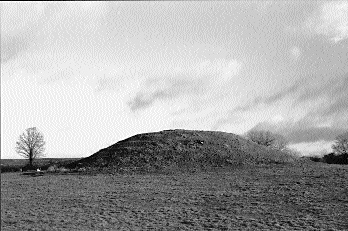
Sliabh Gabhra, Cornashee, inauguration place of the Maguire of Fermanagh.
The uncustomary venue for the speedy nomination of all these lords, by which means O’Neill secured them as allies, appears to have been a ringfort in the townland of Gortacur about a mile southwest of Mullach Chruaich, the traditional inauguration place of the O’Molloys. On this occasion, then, traditional observance was by-passed by O’Neill, and those who submitted to him, in deference to greater needs.
Undignified transformation into agricultural land
The abandonment and profanation of traditional gathering sites is poignantly conveyed in a number of bardic poems on the theme of the downfall of the Gael written in the sixteenth and seventeenth centuries. Fear Flatha Ó Gnímh, the ollamh to the Clandeboye O’Neills, decried the undignified transformation of assembly hills into agricultural land; and an anonymous Gaelic poet writing during the period of the Ulster Plantation lamented the absence of the ‘dark-eyed throng around the heights of fortified assembly places’. Gathering sites also vanished from general and regional maps of Ireland drawn from the second decade of the seventeenth century onwards. Prior to that, during the period of the Nine Years War, the Tudor government had seen it as a matter of political expedience to chart the inauguration venues of recalcitrant Ulster chiefs. On their maps of Ulster, the cartographers Francis Jobson and Richard Bartlett carefully noted the O’Neill inauguration site at Tulach Óg in Tyrone, Lios na Ríogh, the place where the Magennis was made chief in Uí Eachach Coba, and Mullach Leic, the MacMahon gathering place in Oirghialla. After the defeat of the combined forces of O’Neill, O’Donnell and their Spanish allies at Kinsale on January 2, 1602, the need to have intelligence of Gaelic strongholds and administrative centres in Ulster had passed. The destruction of the O’Neill inauguration chair at Tulach Óg by Lord Deputy Mountjoy, at the beginning of September 1602, was a powerful symbolic act. The breaking of the chair was a metaphor for the fall of the O’Neill dynasty. After that fall, the process of rearranging the Irish cultural landscape and revising its portrayal commenced.
Far-seeing hills and ridges
What did gathering places used by medieval Gaelic dynasties for inauguration ceremonies and parleys look like? Were they natural places, open fields and hilltops, or were they defined by particular monuments appropriate to the procedure and choreography of assembly? The place-names of assembly sites are a good point at which to start, because in their combinations of topographical terms, allusions to royalty, to a sept name, or a hilltop monument, they often provide clues as to what one might expect to find. Since they had to be both easily accessible and afford a panoramic view over the territory, gathering sites were invariably situated on low-lying but far-seeing hills and ridges. It is hardly surprising then to find that descriptive root-words evoking the idea of height—like ard, cnoc, mullach, tulach and cruachan—are recurrent elements in assembly site place-names. The aptly named Ard na dTaoiseach, [Height of the Chieftains], situated on the western side of the Inishowen peninsula, overlooking Lough Swilly, was used by the O’Dohertys for their inauguration ceremonies in the sixteenth century. Cnoc on Bhogha [hill of the bow] in the barony of Gorey, County Wexford was, according to Geoffrey Keating, the MacMurrough Kavanagh place of inauguration. The word tulach occurs with particular frequency, given for instance to Tulach Óg, [hill of assembly of warriors] and to Tulach Mac Amhalghaidh, the gathering place of the Magawley of Calary in the parish of Ballyloughloe, County Westmeath. Large and small mounds crowning low hills, hilltop enclosures, natural knolls, and less frequently church sites and ringforts on modest heights constitute most of the gathering sites so far identified on the landscape. Earthen mounds, some of which are two-tiered, and either unenclosed or enclosed by a ditch and bank, were preferred venues. None of these has as yet been archaeologically excavated so it is not known whether they are re-used sepulchral monuments or simply earthen platforms put up especially for royal assembly, or a combination of both. The small summit diameter of some of them suggest that they were no more than ‘throne mounds’ accommodating the official inaugurator (either the ollamh or coarb) and the royal candidate who sat in a canopied ‘chair’ or stood placing his foot on a stone. Household officials, military, ecclesiastics, and leading vassals would have attended the event. Other temporary structures such as simple timber-framed or wattle-and-daub shelters may also have been erected in the vicinity.
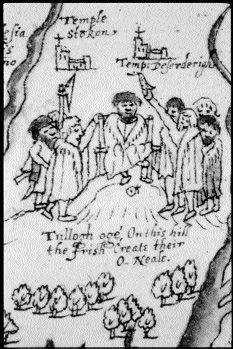
The performance of the rite of the single shoe during the inauguration of the O’Neill at Tulach í“g, from an early seventeenth-century map of Ulster. The O’Neill is shown seated in the stone inauguration chair which is elevated on a small mound. (Dartmouth Collection, National Maritime Museum, Greenwich)
The place-names of these mound sites usually incorporate the word carn, which can mean a pile or heap of any material, and the word cruachan which variously refers to a heap, a conical pile or hill. Among the mounds known to have been used for late medieval Gaelic inauguration ceremonies are Carn Inghine Briain in Tír Fhiachrach where the O’Dowda chiefs were elected from the mid- fourteenth century onward, Carn Í Eaghra where the O’Hara of Luighne was made, and Cruachain Ó Cupráin near Killeshandra in Cavan where the O’Rourke of West Bréifne was proclaimed.
Stone chairs
The use of the word leac [flagstone, bedrock or paving-stone] in gathering-site place-names is especially significant as it hints at the presence of inauguration ‘furniture’, whether in the form of an unadorned flagstone, a footprint stone or more ambiguously a ‘chair’. The O’Neill stone chair was illustrated by the Tudor cartographer Richard Bartlett on the eve of its destruction in 1602. He shows a crude object composed of four separate pieces—a cumbersome base which may be the original Leac na Ríogh [flagstone of the kings] to which the other three pieces—the back and two sides or arms—were later added. This may have been done during the fourteenth century when O’Neill dynasts invented the title Rex Ultonie or Rí Uladh for themselves along with a range of other propaganda devices like the Red Hand badge. Possibly the only surviving Gaelic Irish inauguration chair is that attributed to the Clandeboye branch of the O’Neills—a crude chair-shaped monolith housed in the Ulster Museum. This could have been modeled on the Tulach Óg chair in the fifteenth century when the Clandeboye O’Neills extended their dominion east of the Lagan into south Antrim and north Down and established their new headquarters at Castlereagh. The MacMahons may also have had a stone chair at their inauguration site of Mullach Leic in Monaghan (the place-name intimates flagstones on the summit of a hill), as perhaps too did the Clanrickard Burkes—at least until 1543 when Ulick na gCeann Burke was created Earl and the Gaelic title of Mac William Uachtair became defunct.
Antiquity and continuity
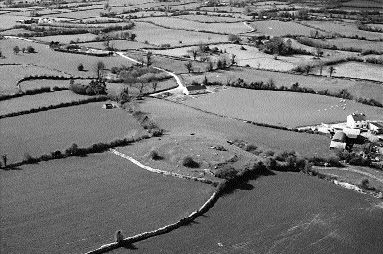
An enclosure crowning Tulach Mac Amhalghaidh (at centre of picture), the gathering place of the Magawleys of Calary, near Moate, County Westmeath.
The place of inauguration and assembly in a Gaelic lordship was frequently but not exclusively situated within the estate of the inaugurator and sometimes adjacent to the lucht tighe or mensal lands. The site for such important occasions was not arbitrarily chosen. An existing burial mound may have been adopted and modified for use as a place of assembly because it had associations, legendary or otherwise, with the progenitor of a sept name. Some early medieval tribal groups like the Cenél Eóghain and their O’Neill descendants, or the Dál gCais ancestors of the Thomond O’Briens, claimed their king-making sites from rival septs as a result of expansion. The idea that gatherings and inaugurations were regularly convened to boundary areas does not hold true in most cases. While a meeting-place would have been customary for most septs, not every sept had its own inauguration site. The vassal status of the MacSweeney of Fanad, for instance, meant that he was inaugurated at Cill Mhic Nénáin—the election place of his O’Donnell overlord which, in this instance, happened to be in the boundary area between Fanad and Tír Conaill. The period of time over which particular sites were used for assembly activity varies. Tulach Óg was the inauguration place of the O’Neills for about 600 years, while the great mound of Magh Adhair near Toonagh County Clare served Dál gCais assemblies perhaps as early as the ninth century and the inauguration ceremonies of O’Brien opponents of the Earl of Thomond as late as the end of the sixteenth century. This sort of antiquity and continuity of use, however, does not characterise all inauguration sites. The Maguires would not have adopted the mound of Sciath Ghabhra as their inauguration venue until they first became overlords of Fir Manach in 1264. When the O’Dowda reclaimed Tír Fhiachrach from the de Berminghams in the mid-fourteenth century the focus of their inauguration ceremonies became Carn Inghine Briain, east of the River Moy. Newcomers to Gaeldom, like the Mayo and Galway Burkes of Anglo-Norman stock, who adopted Gaelic election customs and open-air gathering sites in the mid-fourteenth century, tended either to take on the royal assembly place of the territory they claimed or choose a new site devoid of any previous kingship associations.
Inauguration ceremonies in later medieval Ireland had set and long-established rites, but it would be misleading to think that the precepts of royal ritual remained unchanged for centuries. At least five different rites have been documented. The sequence of their performance and the extent to which they occurred in combination is, however, unclear. The elaborate ritual variously involved robing of the royal candidate, the performance of a deiseal or clockwise ceremonial turn, the rite of the single shoe, proclamation by the inaugurator, acclamation by the gathering, and the surrendering of the newly elected chief’s horse and raiment to the inaugurator or leading churchman. The principal ritual prop and symbol of legitimate authority was a simple rod or wand of hazel referred to as slat na ríghe [rod of kingship] and later slat tighearnais [rod of lordship]. Additional rites may have included bathing, the chanting of the chief-elect’s genealogy, and possibly the recitation of an inaugural ode composed specially for the occasion. The ceremony culminated in feasting; and it seems that as late as the sixteenth century a creach [cattle raid] was the expected first duty of the newly elected royal. While we know something of the Gaelic inauguration ceremony, considerably less is known about the mechanism by which lordship oireachtais [parliaments] were called, and whether they occurred on a regular basis and had structured democratic procedures.
Collapse of the Gaelic order
After the collapse of the Gaelic order the tulach tinóil lost its purpose and centrality. One might expect that traditional gathering places would have been later used for the election of Catholic rebel leaders during the period of the 1641 Rebellion, but evidence from the Protestant Depositions suggests that sites other than the old assembly haunts were more frequently used. While the O’Hagan rebel captains appropriately mustered in April 1642 at Tulach Óg (their predecessors had been stewards to the O’Neills and keepers of the inauguration site as early as the mid-eleventh century), rebels in Ely O’Carroll met at Ballybritt Castle, and the Dominican Friary in Sligo town was the regular venue for Catholic recusant rallies in that county. What is more interesting about the activities of the rebels was their determination to set up new provincial ‘kings’ and a ‘king of Ireland’, which was a throwback not to Gaelic lordship but to early medieval archaic kingship. There were calls to make the Maguire ‘king of Ireland’, and from the walls of Carlow Castle, O’Byrne and Kavanagh rebels taunted the loyal townspeople with promises to make Murtough Oge Kavanagh ‘king of Leinster’. The widow of the clerk of Roscommon town reported that in 1643 all the rebel soldiers of the district had gone to Tulsk to make Charles O’Conor Dun of Ballintubber ‘king of Connacht’. Tulsk is a small village which lies midway between Rathcroghan, the ancient seat and provincial inauguration place of the kings of Connacht, and Carn Fraích, the local inauguration place of the O’Conor dynasts of Síl Muiredaigh from whom the kings of Connacht were drawn as early as the ninth century. While it is tempting to suggest that the O’Conor Dun may have been inaugurated at Rathcroghan or Carn Fraích in 1643, the widow’s deposition does not specify that either place was used. The event could also have been held at the Dominican abbey or the castle in Tulsk village itself.
Places of rural public protest?
There are rare historical moments in nineteenth-century Ireland when known medieval Gaelic assembly sites were used for rural public protest. But to what extent do these represent continuity of authoritative folk memory of significant places in the old Gaelic landscape? Once a place and its surroundings have been altered or its function changed, recollections of it become unreliable. The delicate strings that tied nineteenth-century Irish rural peoples to their Gaelic past were made of a peculiar weave of shadowy fact and outright fiction. It is in this nineteenth-century aetherial world of suggestion that the last threadbare references to the Gaelic practice of outdoor assembly and inauguration ceremonial is to be found, some of which were recorded by John O’Donovan during the first Ordnance Survey of Ireland. Very occasionally sites which had been frequented for gatherings in late medieval Gaelic lordships feature in the narrative of nineteenth-century anti-tithe rallies. In c. 1840 a deputation of the people of the Barony of Roscommon announced to Matthew O’Conor of Belnagare (uncle of the O’Conor Dun) that at a general meeting ‘it was proposed, and unanimously resolved that he should be proclaimed king of Connaught’. As in 1643, the call was again for a provincial king and not simply an O’Conor chief. The deputies asked him to appoint a time for the ‘performance of the ceremony, on the hill of Carnfree [Carn Fraích]’. Likewise, in 1836 a delegation of the people of Cavan, ‘groaning beneath the iron yoke of slavery’, determined to elect a new O’Reilly to lead their protest against the landlords Beresford and Farnham. Having renounced the truant representative of the name, Myles O’Reilly, who was then residing in County Laois, they resolved never to let him set his foot on Shantemon Hill, the late medieval O’Reilly inauguration and oireachtas venue, in the remote countryside east of Cavan town.
The fact that a hillside or hilltop had once been the hallowed tulach tinóil of a particular Gaelic lordship was not by any means the compelling criterion in site selection for nineteenth-century rural crowd activity, any more than it was for Catholic rebel meetings in 1641-3. On the contrary, pragmatism and the need for cause-appropriate symbolism more often influenced where these gatherings took place, just as different sets of circumstances had earlier dictated the choice of Gaelic inauguration and assembly sites.
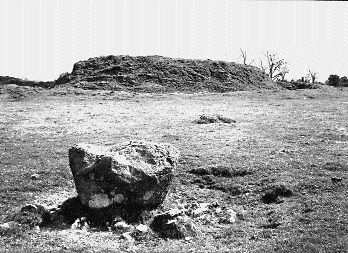
The great mound of Magh Adhair near Toonagh, County Clare, with basin-stone in foreground-assembly place of the Dál gCais and their O’Brien descendants. (Díºchas, The Heritage Service)
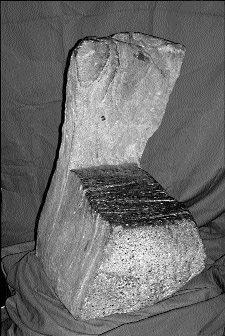
The reputed Clandeboye O’Neill inauguration chair, which stood on Castlereagh Hill, County Down, until c.1750. (Ulster Museum)
Added to that, the fact is that more often than not the original significance of a place was lost to the majority of the people who attended meetings there. An anti-tithe or repeal rallying ground could be a new site with no tradition of assembly, chosen simply because it was an easily accessible open space capable of accommodating thousands of people. It could also be a site of more remote antiquity, or one that had witnessed conflict. It is interesting that of all the sites chosen by O’Connell for his repeal meetings, in the 1840s, not one had been a former tulach tinóil of a Gaelic lordship. As Maura Cronin has shown in her recent work on O’Connellite crowds, sites that had witnessed conflict, and would therefore strengthen the resolve of the crowd, were frequently selected. Mullaghmast, County Kildare, was chosen by O’Connell as a meeting ground not because it had once been the renowned royal site of Maistiu but because it had been the scene of the massacre in 1577 of Moris O’More and some forty of his O’More and O’Connor kinsmen by Laois-Offaly planters. Tara and Cashel were deemed appropriate rallying grounds for O’Connell’s meetings because in the romantic revision of the Irish past (whereby the down-at-heel Gael was transformed into the Celtic hero) these places evoked more halcyon days of archaic kingship. Tara’s associations with high-kingship gave it an enduring, potent symbolism. It was the location of rebel meetings during the 1641 Rebellion and there are at least two recorded instances of Gaelic chiefs ceremonially shoeing their horses there in the sixteenth century. Sir John Perrot in his Chronicle of Ireland, 1584-1608 describes Hugh O’Neill’s incursions into the Pale and his coming to the Hill of Tara where he shod his horse ‘attended with greate troupes.’ The ‘old doatinge prophesie was that if Oneale could come and shoe his horse he should be kinge of all Ireland’. The same gesture had been performed earlier in 1527 by the O’Connor of Offaly who, having invaded the Pale as far as Gormanstown, came to Tara and there in a large gathering of his kinsmen and followers ‘shoed his horse, for a great honour as he took it’.
This type of throwback to remote antiquity is a recurring theme in the choice of gathering sites. As late as 1901 Douglas Hyde and J. P. Henry addressed an Irish language movement rally attended by some 8,000 people on Garland Sunday, at Aughris, County Sligo.
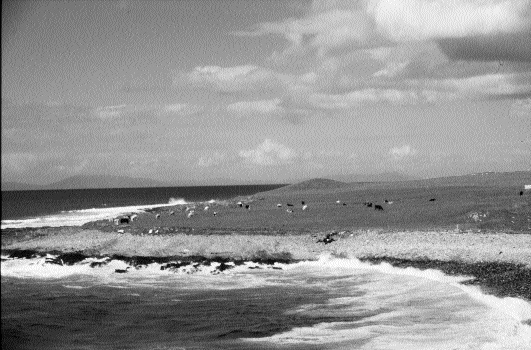
View along the western coastline of Aughris headland-‘The Tara of Tireragh’–County Sligo.
For reasons undocumented and long lost in oral tradition, Aughris headland on the north Connacht coastline was then still regarded as the ‘Tara’ of the barony of Tireragh, the ‘trysting place for great and renowned gatherings’. Reporting on the Irish language movement rally, The Sligo Champion (3 August, 1901), recorded that:
The place of meeting was no less appropriate for such an occasion, as Aughris has many historic associations which recall the days when our grand old language flourished and the language of the foreigner was unknown. Besides, Aughris has many attractions peculiarly its own. Apart from the wild grandeur of its towering cliffs and yawning chasms around the headland, there is obtained from its summit most charming views of mountain, sea, and land.
In this instance, the rallying ground was chosen not simply because of its splendid location but because it had more ancient assembly connotations which, however, were by then only vaguely understood. Aughris was in fact a Lughnasa festive site and recent research suggests that it may also have been the location of an early medieval tribal assembly and the late medieval inauguration place of the O’Dowda.
Conclusion
While some medieval gathering-sites like Aughris, Carn Fraích and Shantemon enjoyed what was either a measure of continuity of use or revival of use by activists, well into the nineteenth and early twentieth century, the history of Irish meeting-culture clearly shows that there was no strict allegiance to traditional gathering places. Ancient sites and monuments which had no previous assembly associations, but had a pertinent historical message, or natural open places with fine views, were also chosen as circumstances and causes required.
Elizabeth FitzPatrick lectures in medieval archaeology at the National University of Ireland, Galway
Further reading:
E. FitzPatrick, ‘The inauguration of Tairdelbach Ó Conchobair at Áth an Termoinn’, in Peritia, 12 (1998).
K. Simms, From Kings to Warlords: the changing political structure of Gaelic Ireland in the later middle ages (Woodbridge 1987, 2000).
P. Jupp and E. Magennis (eds.), Crowds in Ireland c. 1720-1920 (Basingstoke, London and New York 2000).
















